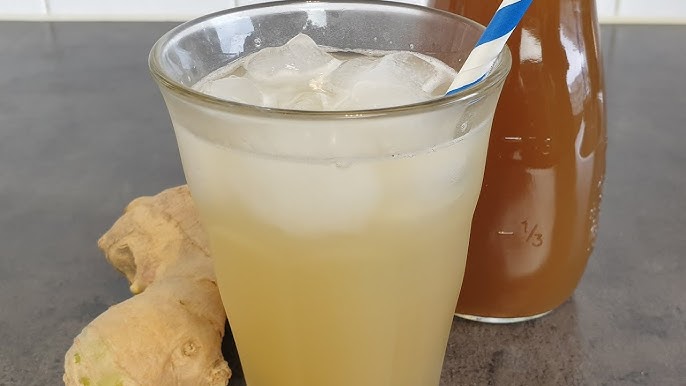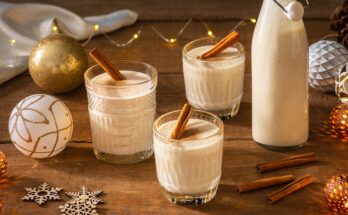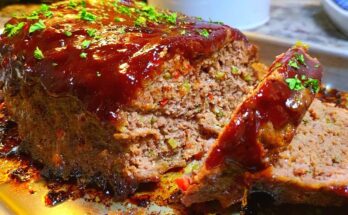Ginger Ale Recipe: Ginger ale isn’t just a fizzy drink you grab from the store when your stomach is feeling off. It’s a delicious, zesty, and refreshing beverage that you can easily make at home. And trust me, once you taste homemade ginger ale, you’ll never want to go back to the canned version.
At its core, ginger ale is a carbonated drink flavored with ginger, sweetener, and citrus. What makes it shine, though, is its versatility. You can enjoy it on its own, use it as a mixer, or sip it as a soothing remedy on a sick day. But what really sets it apart is how easy it is to control the flavor when you make it yourself—from the spice level to the sweetness to whether it’s fermented or not.
So, why settle for store-bought versions full of additives and artificial flavors when you can whip up a batch of this golden goodness in your own kitchen? Let’s break it all down.
Health Benefits of Ginger Ale
Ginger has been used for centuries in traditional medicine—and for good reason. When used in ginger ale, it brings a whole slew of health benefits that make this drink more than just a tasty treat.
- Digestive Aid: Ginger naturally soothes the digestive tract. Homemade ginger ale can help with bloating, nausea, and indigestion. It’s like a hug for your gut.
- Anti-Inflammatory Properties: Ginger contains gingerol, a compound known for reducing inflammation and fighting oxidative stress.
- Caffeine-Free Refreshment: Unlike cola or energy drinks, ginger ale is completely caffeine-free, making it an excellent option for anyone trying to cut back.
- Immune Booster: Ginger and lemon together form a powerhouse combo for supporting the immune system—especially during cold and flu season.
This isn’t just soda—it’s wellness in a glass.
Types of Ginger Ale
Before we get into making your own, let’s clear something up: not all ginger ales are created equal. Here are the main types:
- Dry Ginger Ale: This is what most people are familiar with. It’s lighter in flavor and usually less spicy. Canada Dry is a classic example.
- Golden Ginger Ale: Think stronger, richer, and spicier. This old-school version packs a more authentic ginger punch.
- Fermented Ginger Ale: Made using a natural fermentation process with ginger bug or yeast, this version is naturally carbonated and probiotic-rich.
Depending on your taste preferences and health goals, you might lean toward one type over another. The good news? You can try them all at home.
Homemade vs Store-Bought Ginger Ale
Ever flipped over a can of commercial ginger ale and read the ingredients? You’ll often find high-fructose corn syrup, caramel coloring, and barely a whisper of real ginger.
Here’s why homemade wins every time:
| Feature | Store-Bought | Homemade |
|---|---|---|
| Real Ginger Flavor | Weak or artificial | Bold and authentic |
| Sweeteners | Corn syrup/artificial | Sugar, honey, or natural |
| Preservatives | Yes | No |
| Customization | None | Full control |
| Health Benefits | Minimal | Rich in real nutrients |
So if you care about taste, health, and quality, homemade is a no-brainer.
Ingredients You’ll Need
Let’s gather the essentials. This recipe uses simple ingredients you might already have in your kitchen.
Core Ingredients
- Fresh Ginger Root (1 cup, peeled and grated)
- Sugar or Honey (1 cup – adjust to taste)
- Water (2 cups for syrup)
- Lemon or Lime Juice (¼ cup for a citrusy zing)
- Sparkling Water or Club Soda (4 cups, chilled)
Optional Add-ins
- Cinnamon Stick
- Fresh Mint Leaves
- Cloves or Cardamom
- Vanilla Extract
- Cayenne Pepper (for a spicy twist)
Each ingredient serves a purpose. Ginger provides the base flavor, sugar or honey adds sweetness, citrus balances it out, and sparkling water gives it the fizz.
Essential Tools and Equipment
You don’t need fancy gadgets. Just a few basics:
- Medium Saucepan – for boiling the ginger syrup
- Grater or Food Processor – to grate the ginger
- Fine Mesh Strainer or Cheesecloth – for straining the syrup
- Measuring Cups and Spoons – accuracy matters
- A Glass Jar or Bottle – for storing the final drink
Now that your kitchen is ready, let’s move to the fun part—making your very own ginger ale!
Step-by-Step Guide to Making Ginger Ale
Alright, let’s get into it. Making ginger ale from scratch is easier than you think. Follow these simple steps:
Step 1: Peel and Grate the Ginger
Start by peeling your ginger root. A spoon works better than a knife—it helps you scrape the skin off without wasting too much of the root. Once peeled, grate the ginger using a fine grater or a food processor. You’ll need about 1 cup of grated ginger for a strong, punchy flavor.
Want it milder? Use half a cup instead. Like it spicy? Don’t hold back.
Step 2: Make the Ginger Syrup
Add your grated ginger to a saucepan along with 2 cups of water and your choice of sweetener (sugar or honey). Bring the mixture to a gentle boil, then reduce the heat and let it simmer for 10–15 minutes. Stir occasionally.
This simmering time is where the magic happens—the ginger releases all its spicy, fragrant oils into the syrup.
Step 3: Strain the Syrup
After simmering, remove the pan from heat and let it cool slightly. Then, pour the syrup through a fine mesh strainer or cheesecloth into a clean container. This removes the ginger pulp and leaves you with a smooth, golden syrup.
Press the pulp gently to squeeze out every drop of flavor. Don’t rush this step—it makes all the difference.
Step 4: Add Citrus Juice
Once the syrup is strained, stir in about ¼ cup of lemon or lime juice. This brightens up the drink and adds a refreshing citrus twist.
Step 5: Mix with Sparkling Water
Now it’s time to assemble the drink. In a tall glass filled with ice, combine about ¼ cup of ginger syrup with 1 cup of chilled sparkling water or club soda. Adjust based on your taste preference.
Like it sweeter? Add more syrup. Prefer it fizzier? Add more soda.
Step 6: Chill and Serve
Give your drink a gentle stir, garnish with a lemon wedge or mint sprig, and serve immediately. Refreshing, flavorful, and homemade!
Alternative Sweeteners and Flavor Twists
Not a fan of regular sugar? No worries. The beauty of homemade ginger ale is that you can make it your own—right down to the type of sweetener or flavor twist you prefer. Here are a few exciting alternatives and add-ins that will take your ginger ale to the next level.
Natural Sweeteners
- Honey: Adds floral notes and natural antibacterial properties. It pairs well with the spicy warmth of ginger.
- Maple Syrup: Offers a rich, earthy sweetness that brings a unique depth to the drink.
- Agave Nectar: Sweeter than sugar, yet low-glycemic. Perfect if you’re looking to keep things a bit healthier.
- Stevia or Monk Fruit: For a sugar-free option, these plant-based sweeteners work great. Just be careful with measurements—they’re much sweeter than sugar.
Flavor Twists
- Mint Leaves: Toss a few into your glass for a cooling sensation.
- Fresh Berries: Muddle raspberries or blueberries for a fruity variation.
- Spices: Cardamom, cinnamon, or clove add a warm, exotic touch.
- Vanilla Extract: Just a drop can give your ginger ale a soft, creamy aftertaste.
- Cucumber Slices: Light and refreshing, ideal for a spa-like vibe.
Whether you’re making this for yourself or impressing guests, playing with flavors is half the fun. Just make sure to taste as you go—you’re the artist here.
How to Make Fermented Ginger Ale (Probiotic Version)
Ready to level up your ginger ale game? Enter: fermented ginger ale. Not only does it bring a natural fizz, but it’s also packed with probiotics that are great for gut health. This version takes a bit longer to make, but the end result is worth the wait.
Ingredients You’ll Need
- 1 cup fresh ginger (grated)
- ½ cup sugar (for feeding the bacteria)
- 4 cups water
- 2 tablespoons lemon or lime juice
- ¼ cup of ginger bug (a wild ferment made from ginger, sugar, and water)
Steps for Fermentation
- In a clean jar, mix grated ginger, sugar, water, and citrus juice.
- Add ¼ cup of your ginger bug to the mix.
- Stir well, cover the jar loosely with a cloth or paper towel, and let it sit at room temperature.
- Leave it to ferment for 2–3 days, checking daily. You’ll see bubbles forming—that’s a good sign!
- Once bubbly and slightly fizzy, strain the liquid and pour into airtight bottles.
- Seal and let sit for another 1–2 days at room temperature to carbonate. Be careful—pressure builds fast.
After fermentation, refrigerate to stop the process. Open slowly and enjoy a naturally fizzy, probiotic-rich ginger ale.
Tips for the Best Flavor
Even though the process is simple, there are a few pro tips to really make your homemade ginger ale shine:
- Use Fresh, Organic Ginger: Older ginger can taste woody and dull. Fresh ginger root has more oils and spice.
- Don’t Overboil: Simmer the syrup gently to avoid burning the sugars or destroying the flavor compounds.
- Balance the Citrus: Lemon or lime juice balances the sweetness and heat. Too much citrus can overpower the ginger.
- Chill Before Mixing: Both the syrup and soda should be cold for the best carbonation and taste.
- Taste Test Everything: Your taste buds are the final judge—adjust sweetness, spice, and tartness to your liking.
Homemade drinks should reflect your preferences, so don’t be afraid to experiment!
Common Mistakes to Avoid
Let’s be honest—sometimes kitchen projects don’t go quite as planned. Here are a few common ginger ale mistakes and how to avoid them:
1. Using Too Much Ginger
Yes, we love ginger—but too much can make the drink overpowering and hard to enjoy. Stick to 1 cup grated ginger per 2 cups water, and adjust from there.
2. Skipping the Straining Step
Unstrained ginger syrup can leave you with a gritty, unpleasant texture. Always use a fine mesh strainer or cheesecloth for the smoothest result.
3. Not Cooling the Syrup Before Mixing
Mixing hot syrup with soda will kill the fizz instantly. Let everything cool to room temperature or chill it beforehand.
4. Using Flat Soda
Sparkling water should be fresh and fizzy. Flat soda means a flat drink. Pour gently to keep the bubbles alive.
5. Storing Improperly
Without preservatives, homemade ginger ale won’t last forever. Always refrigerate and consume within a week.
Avoiding these pitfalls will save you time, effort, and disappointment.
Serving Suggestions
Homemade ginger ale is more than just a drink—it’s a vibe. Here’s how to serve it up in style:
Best Times to Serve
- After Meals: As a natural digestive aid.
- At Parties: Use it as a mocktail base or a mixer with whiskey, rum, or vodka.
- During Hot Weather: Ice-cold ginger ale hits the spot on summer afternoons.
- For Upset Stomachs: Keep it simple, without soda, and sip it warm or at room temperature.
Pairing with Food
- Pairs beautifully with spicy dishes, BBQ, grilled fish, or Asian stir-fries.
- Refreshing against rich, creamy desserts like cheesecake or flan.
Garnish Ideas
- Fresh mint sprigs
- Lemon or lime wheels
- Sliced strawberries
- Crushed ice with a cinnamon stick
Presentation matters. A well-garnished glass of ginger ale feels like a treat.
How to Store Homemade Ginger Ale
Homemade ginger ale doesn’t contain preservatives, so you’ll need to store it properly.
For Syrup Only
- Store in a clean glass jar or bottle.
- Keep refrigerated.
- Lasts 1 to 2 weeks.
For Mixed Ginger Ale
- Best consumed fresh.
- If storing, seal tightly and refrigerate.
- Try to drink within 24–48 hours for best fizz and flavor.
For Fermented Ginger Ale
- Store in sealed bottles in the fridge.
- Burp the bottles (open them slightly) every couple of days to release pressure.
- Lasts up to 2 weeks but flavor changes over time.
Keep an eye on color, smell, and taste—if anything seems off, toss it out. Better safe than sorry.
FAQs about Ginger Ale Recipe
1. Is Ginger Ale Good for Nausea?
Absolutely. Ginger is known for easing nausea, and a lightly sweetened, non-carbonated version of ginger ale can be especially soothing for an upset stomach.
2. Can I Make Ginger Ale Without Sugar?
Yes! Use natural sweeteners like stevia, monk fruit, or erythritol. Just remember: fermentation (if you’re doing it) requires real sugar to feed the bacteria.
3. Is Homemade Ginger Ale Carbonated?
It can be. If you mix with sparkling water, it’s instantly carbonated. If you go the fermentation route, it carbonates naturally over time.
4. How Long Does It Take to Make Ginger Ale?
The quick version (non-fermented) takes about 30–45 minutes. Fermented ginger ale takes 3–5 days depending on your fermentation method.
5. What’s the Difference Between Ginger Ale and Ginger Beer?
Ginger beer is fermented longer and has a much stronger ginger flavor, often with more spice and a cloudy appearance. Ginger ale is typically lighter and sweeter.
Conclusion
Making ginger ale at home is more than a DIY kitchen project—it’s a celebration of flavor, wellness, and creativity. From its healing properties to its refreshing taste, ginger ale stands out as one of those rare drinks that feels indulgent yet beneficial. And now that you know how easy it is to craft it at home, you can ditch the store-bought cans for good.
Whether you want a quick, fizzy soda-style refreshment or a probiotic-rich fermented elixir, this guide gives you all the tools and tips to get started. So go ahead—grab some ginger, roll up your sleeves, and start brewing. Your tastebuds (and your gut) will thank you.



